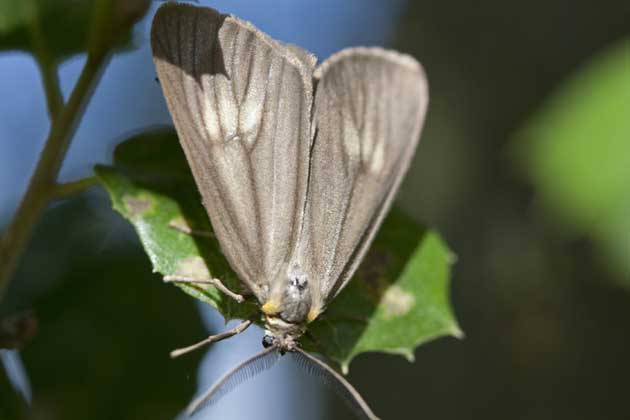I’ve noticed lots of butterflies (moths?) in the Indian Valley Open Space area of Novato (oak forest). I haven’t seen this many in previous years. The butterflies are about the size of a nickel or quarter and are white. What kind of butterfly are they? What is their natural predator? Any reason they are so abundant this year? Bob Skinner, Novato
According to a number of entomologists, they’re likely to be California oak moths (Phryganidia californica). The moths are especially abundant in Marin this year and thrive in warm, dry winters. Steven Swain, an environmental horticulturalist with the UC Cooperative Extension based in Marin, says that there are two factors that keep the moths in check: predators and cold winters. But it’s mainly cold winters, he says, because the predators that eat specifically oak moths exist in low numbers until the moth populations boom. (There are general predators: birds, spiders and five-spined soldier bugs, that will opportunistically eat oak moths, but they don’t make enough of a diet of them to really control the population.)
In warm winter like this one, the moths can lay millions of eggs before the predators wake up to the new feast, and then it’s too late for the predators to catch up. Thanks to the warm and dry January and February, the moths were able to get started hatching early, and they’ve been able to proceed through three generations this year – most years, they only get two — leading to this outbreak year. They’ll probably start to taper off, Swain says, in the next few weeks as the weather turns colder.
They’re unlikely to return in such numbers next year, though: the predators will boom now, plus oak moths tend to eat their way through everything and then crash in five and seven year cycles. Like the 17-year cicadas that bloomed on the East Coast this summer, oak moths seem to find a significant evolutionary advantage in prime-numbered generations that make it difficult for predators to discern a reproductive pattern. Watch out for them, then, in 2018 and 2020.
Find more information on California oak moths at the UC Integrated Pest Management California Oakworm Management Guidelines page.
Got a nature question? Ask the Naturalist!





